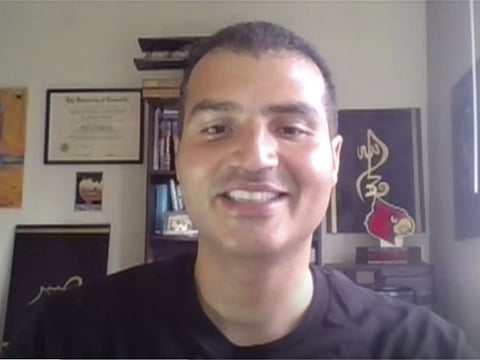Gaza man behind Mars drone says visiting home is no small step
Elbasyouni struggled to afford tuition in Kentucky as family farm was bulldozed in Gaza

Beit Hanoun, Gaza Strip: An electronics engineer from Gaza, Loay Elbasyouni, had worked with the NASA team that made history this month by launching an experimental helicopter from the surface of Mars.
But he says an expedition to his hometown in the Gaza Strip, where posters celebrate his achievement, feels even farther away because of Israeli and Egyptian restrictions.
“When you deal with electrons and technology, you can calculate things and know their path,” he told The Associated Press in a video interview from his home in Los Angeles. “When you deal with people and politics, you don’t know where things can go.”
The 42-year-old has himself made an astonishing journey from the hardscrabble town of Beit Hanoun near the heavily-guarded Israeli frontier to the US space agency’s Jet Propulsion Laboratory in California, where he worked as a contractor helping design the Ingenuity helicopter.
He left Gaza in 1998 to study in the United States and has only returned once, for a brief visit in 2000 prior to the second Palestinian intifada, or uprising, late that year. Some 6,000 Palestinians and 1,000 Israelis were killed in fighting, attacks and Israeli military operations before the violence ebbed in 2005.
The fighting was especially intense in and around frontier towns like Beit Hanoun. Elbasyouni says Israeli military tanks bulldozed his father’s fruit orchards on four occasions.
Israel withdrew from Gaza in 2005, but two years later Hamas seized power from rival Palestinian forces. Since then, Israel and Egypt have maintained a blockade that strictly limits the movement of people and goods in and out of the narrow coastal strip, which is home to more than 2 million Palestinians.
As Gaza weathered one crisis after another, Elbasyouni pursued his studies in the US.
He struggled to afford tuition at the University of Kentucky, especially after the family farm was bulldozed. At one point he said he worked more than 90 hours a week at a Subway sandwich shop to make ends meet. He eventually transferred to the University of Louisville, where he earned bachelor’s and master’s degrees in electrical engineering.
In 2012 he was hired by a technology company that was developing electric aircraft. Two years later, the company was contracted by NASA for the Mars helicopter project, and Elbasyouni was promoted to lead electronics engineer.
He spent six years working alongside other NASA scientists to develop the helicopter’s propulsion system, its controller and other key components.
The robotic helicopter he developed hitched a ride to Mars on the Perseverance rover, which was launched into space on a rocket in July. He said his feelings were “indescribable” when he watched it touch down on the surface of the red planet in February.
Elbasyouni followed every moment of the expedition, and nervously awaited any signal the helicopter was working once it was launched. When the first images reached Earth showing the helicopter taking flight, “I screamed in the middle of night and woke up everyone in the building,” he said.
It was a triumph hailed as a Wright brothers moment in the history of flight. Since then, Elbasyouni has done numerous TV interviews with Western and Arab media and become a hometown hero in Beit Hanoun.
But he says he’s unlikely to visit anytime soon because of the travel restrictions.
If he wanted to visit he would have to go through Jordan or Egypt, as Israel does not allow Gazans to fly in or out of its international airport.
In Jordan, he would have to wait for a special shuttle to take him from the Allenby Bridge crossing across the Israeli-occupied West Bank and Israel to the Erez Crossing with Gaza. The irregular shuttle only runs every few days. Each direction would require an Israeli permit, a process that can be complicated, time-consuming and uncertain.
Exit permits are usually only granted to patients seeking life-saving medical treatment or a small number of businessmen.
His other option would be to go through Egypt and try to enter Gaza through the Rafah crossing, which only opens sporadically and can be closed for months at a time.
Elbasyouni points out that most Americans, including space engineers, only get two or three weeks off a year. “If you go (to Gaza), you may get stuck and lose your job,” he said.
The restrictions on all sides have been tightened since the start of the coronavirus pandemic but long predate it.
Israel says they are necessary to contain Hamas, which has fought three wars with Israel and is considered a terrorist group by Israel and Western countries. COGAT, the Israeli military body in charge of coordinating civilian affairs in the West Bank and Gaza, says it considers individual requests and allows travel for humanitarian cases.
Each request, it said, receives “a thorough examination that involves all the relevant professional offices and subject to security considerations.”
Critics of the blockade say it amounts to collective punishment, with generations of Gazans confined to a vast, open-air prison.
Gisha, an Israeli rights group that closely follows the closures and advocates for freedom of movement, says the “severe, sweeping restrictions” mean that “Gaza’s future scientists, entrepreneurs, and innovators are blocked from accessing potentially life-altering educational and professional opportunities outside the Strip.”
Despite the political situation, Elbasyouni says there are still opportunities for Palestinian entrepreneurs and innovators, even in Gaza, and he hopes that he can provide inspiration for young Palestinians.
“Being part of this project that serves humanity is a source of huge pride,” he said.
Sign up for the Daily Briefing
Get the latest news and updates straight to your inbox









